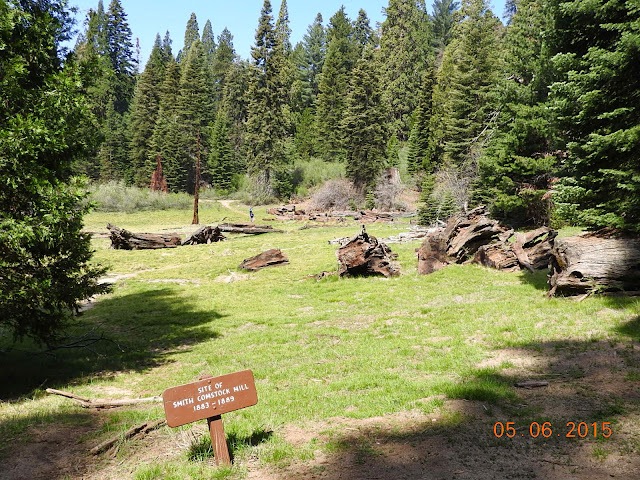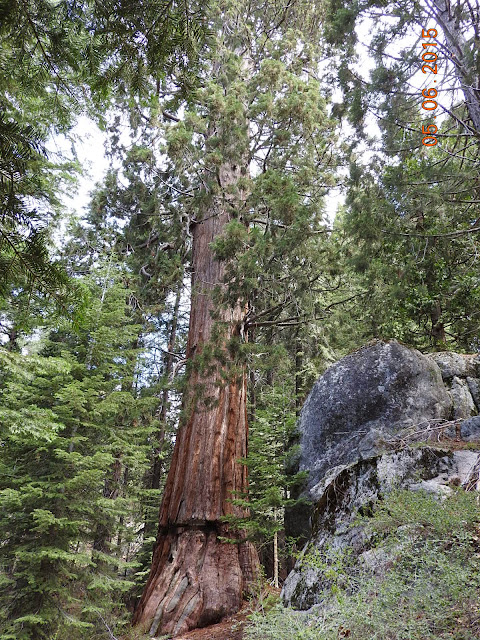Wednesday, May 6, 2015
Well after we quit stopping and looking at various crops, we finally arrived at Big Stump Entrance of Sequoia National Forest about 10:30 am.
The Big Stump Trail is about 2 miles long. We parked in the parking lot and took off on our hike.
On the early part of the trail we saw this huge Sequoia.
I'm standing in the dark spot in the picture above. This gives a perspective on the immensity of this tree.
This is the other side of the same tree. See picture below.
Look at the size of the scar on the bottom part of the tree. Tic is stretched as far as he can stretch. HUGE tree.
This is a very large Ponderosa Pine. My silly guy is standing there to give perspective to the size of the tree. While this tree is large, the Sequoias in the area dwarf the Ponderosa Pines.
I really like this perspetive Tic took of this dead Sequoia.
Along the way we came to this open area. As you can see this was the site of the Smith Comstock Mill which was in operation from 1883 - 1889.
Wood from mature giant sequoias is highly resistant to decay, but due to
being fibrous and brittle, it is generally unsuitable for construction. Due to their weight and brittleness, trees would often shatter when
they hit the ground, wasting much of the wood. Loggers attempted to
cushion the impact by digging trenches and filling them with branches.
Still, as little as 50% of the timber is estimated to have made it from
groves to the mill. The wood was used mainly for shingles and fence
posts, or even for matchsticks & toothpicks. Wikipedia
Here's a large stump we came upon. There were several around. We still have not reached the "Big Stump".
All the stumps are so interesting and have such character.
We finally made it to the "Big Stump" of the Mark Twain tree.
The information sign told us that this 1350 year old tree was cut down by 2 men in 1891 for a museum in DC. It took the men 13 days to fell the tree. The museum in DC wanted a slab of the tree to put on display so people in the east could see the immensity of Sequoias. Crazy.
This is what the top surface of the Big Stump look like. See the ladder handle at the top. Also Dusty is standing on the ground. Many of the holes in the top were probably 4-5 ft deep.
As we continued our hike to see the Sawed Tree, there was this rock formation in the middle of no where.
Here is the Sawed Tree. See the scar made from a band saw over 100 years ago. The tree has recovered and is now healthy and growing.
Near the Sawed Tree I was able to pick up 3 kinds of pine cones. The biggest of the cones is about 7 inches long. The 2 big cones come from the Ponderosa Pine. I think the long skinny cones come from the Sugar Pine tree. Then we learned that the small pine cones are from the Giant Sequoias. In our research, the Sequoia cones mature in 18–20 months, though they typically remain green and closed for up to 20 years. Most of the seeds are liberated when the cone dries from fire heat or is damaged by insects.
Look at the character in this dead Sequoia stump. Interesting!
We saw this large tree that was left to rot. Not sure if you can tell the tree broke into 3 sections and goes all the way across a small field. It was huge.
This is an interesting little tree. The bark is red. We also read that the leaves turn vertically so they do NOT get too much sun. We have several larger ones of these trees next to our camp site.
We arrived back at the parking lot and headed to see the General Grant tree.
Here's a tree in the General Grant Tree parking lot. The cars provide some perspective.
Here's the General Grant Tree.
Here's a group of 5 Giant Sequoia also near the parking lot. All these Giant Sequoias are fantastic!
On to Kings Canyon now. See our next post.





















No comments:
Post a Comment